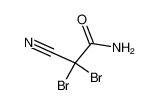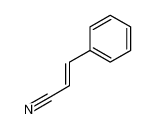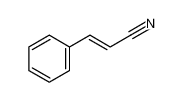| Product name | 2,2-dibromoacetonitrile |
|---|
| Product number | - |
|---|---|
| Other names | EINECS 221-843-2 |
| Identified uses | For industry use only. |
|---|---|
| Uses advised against | no data available |
| Company | MOLBASE (Shanghai) Biotechnology Co., Ltd. |
|---|---|
| Address | Floor 4 & 5, Building 12, No. 1001 North Qinzhou Road, Xuhui District, Shanghai, China |
| Telephone | +86(21)64956998 |
| Fax | +86(21)54365166 |
| Emergency phone number | +86-400-6021-666 |
|---|---|
| Service hours | Monday to Friday, 9am-5pm (Standard time zone: UTC/GMT +8 hours). |
Not classified.
2.2 GHS label elements, including precautionary statements| Pictogram(s) |  |
|---|---|
| Signal word | Warning |
| Hazard statement(s) | H302 Harmful if swallowed H312 Harmful in contact with skin H315 Causes skin irritation H319 Causes serious eye irritation H332 Harmful if inhaled H335 May cause respiratory irritation |
| Precautionary statement(s) | |
| Prevention | none |
| Response | none |
| Storage | none |
| Disposal | none |
none
3.Composition/information on ingredients 3.1 Substances| Chemical name | Common names and synonyms | CAS number | EC number | Concentration |
|---|---|---|---|---|
| 2,2-dibromoacetonitrile | 2,2-dibromoacetonitrile | 3252-43-5 | none | 100% |
Consult a physician. Show this safety data sheet to the doctor in attendance.
If inhaledIf breathed in, move person into fresh air. If not breathing, give artificial respiration. Consult a physician.
In case of skin contactWash off with soap and plenty of water. Consult a physician.
In case of eye contactRinse thoroughly with plenty of water for at least 15 minutes and consult a physician.
If swallowedNever give anything by mouth to an unconscious person. Rinse mouth with water. Consult a physician.
4.2 Most important symptoms/effects, acute and delayedSYMPTOMS: Symptoms of exposure to this compound include irritation of the eyes, mucous membranes and upper respiratory tract, burning sensation, coughing, wheezing, laryngitis, shortness of breath, headache, nausea and vomiting. It is a lachrymator. ACUTE/CHRONIC HAZARDS: This compound may be fatal by ingestion, inhalation or skin absorption. It is an irritant of the eyes, mucous membranes and upper respiratory tract. It is also a lachrymator. When heated to decomposition it emits highly toxic fumes of carbon monoxide, carbon dioxide, nitrogen oxides, bromine, hydrogen bromide gas and cyanides.
4.3 Indication of immediate medical attention and special treatment needed, if necessary/SRP:/ Immediate first aid: Remove patient from contact with the material. Ensure that adequate decontamination has been carried out. If patient is not breathing, start artificial respiration, preferably with a demand-valve resuscitator, bag-valve-mask device, or pocket mask, as trained. Perform CPR as necessary. Immediately flush contaminated eyes with gently flowing water. Do not induce vomiting. If vomiting occurs, lean patient forward or place on left side (head-down position, if possible) to maintain an open airway and prevent aspiration. Keep patient quiet and maintain normal body temperature. Obtain medical attention. /Cyanide and related compounds/
5.Fire-fighting measures 5.1 Extinguishing media Suitable extinguishing mediaFIREFIGHTING. Protective Equipment: Wear self-contained breathing apparatus and protective clothing to prevent contact with skin and eyes.
5.2 Specific hazards arising from the chemicalLiterature sources indicate that this compound is nonflammable.
5.3 Special protective actions for fire-fightersWear self-contained breathing apparatus for firefighting if necessary.
6.Accidental release measures 6.1 Personal precautions, protective equipment and emergency proceduresUse personal protective equipment. Avoid dust formation. Avoid breathing vapours, mist or gas. Ensure adequate ventilation. Evacuate personnel to safe areas. Avoid breathing dust. For personal protection see section 8.
6.2 Environmental precautionsPrevent further leakage or spillage if safe to do so. Do not let product enter drains. Discharge into the environment must be avoided.
6.3 Methods and materials for containment and cleaning upAbsorb on sand or vermiculite and place in closed containers for disposal. Ventilate area and wash spill site after material pickup is complete.
7.Handling and storage 7.1 Precautions for safe handlingAvoid contact with skin and eyes. Avoid formation of dust and aerosols. Avoid exposure - obtain special instructions before use.Provide appropriate exhaust ventilation at places where dust is formed. For precautions see section 2.2.
7.2 Conditions for safe storage, including any incompatibilitiesKeep tightly closed.
8.Exposure controls/personal protection 8.1 Control parameters Occupational Exposure limit valuesno data available
Biological limit valuesno data available
8.2 Appropriate engineering controlsHandle in accordance with good industrial hygiene and safety practice. Wash hands before breaks and at the end of workday.
8.3 Individual protection measures, such as personal protective equipment (PPE) Eye/face protectionSafety glasses with side-shields conforming to EN166. Use equipment for eye protection tested and approved under appropriate government standards such as NIOSH (US) or EN 166(EU).
Skin protectionWear impervious clothing. The type of protective equipment must be selected according to the concentration and amount of the dangerous substance at the specific workplace. Handle with gloves. Gloves must be inspected prior to use. Use proper glove removal technique(without touching glove's outer surface) to avoid skin contact with this product. Dispose of contaminated gloves after use in accordance with applicable laws and good laboratory practices. Wash and dry hands. The selected protective gloves have to satisfy the specifications of EU Directive 89/686/EEC and the standard EN 374 derived from it.
Respiratory protectionWear dust mask when handling large quantities.
Thermal hazardsno data available
9.Physical and chemical properties| Physical state | Clear colorless to yellow liquid |
|---|---|
| Colour | Liquid |
| Odour | no data available |
| Melting point/ freezing point | no data available |
| Boiling point or initial boiling point and boiling range | 163.1ºC at 760mmHg |
| Flammability | no data available |
| Lower and upper explosion limit / flammability limit | no data available |
| Flash point | 31.9ºC |
| Auto-ignition temperature | no data available |
| Decomposition temperature | no data available |
| pH | no data available |
| Kinematic viscosity | no data available |
| Solubility | 5 to 10 mg/mL at 21.5°C |
| Partition coefficient n-octanol/water (log value) | log Kow = 0.47 (est) |
| Vapour pressure | 2 mm Hg at 50°C ; 15 mm Hg at 70°C; 48 mm Hg at 95°C |
| Density and/or relative density | 2.434g/cm3 |
| Relative vapour density | no data available |
| Particle characteristics | no data available |
no data available
10.2 Chemical stabilityStable under recommended storage conditions.
10.3 Possibility of hazardous reactionsDIBROMOACETONITRILE is incompatible with strong acids, strong bases, strong oxidizing agents and strong reducing agents. . Nitriles may polymerize in the presence of metals and some metal compounds. They are incompatible with acids; mixing nitriles with strong oxidizing acids can lead to extremely violent reactions. Nitriles are generally incompatible with other oxidizing agents such as peroxides and epoxides. The combination of bases and nitriles can produce hydrogen cyanide. Nitriles are hydrolyzed in both aqueous acid and base to give carboxylic acids (or salts of carboxylic acids). These reactions generate heat. Peroxides convert nitriles to amides. Nitriles can react vigorously with reducing agents. Acetonitrile and propionitrile are soluble in water, but nitriles higher than propionitrile have low aqueous solubility. They are also insoluble in aqueous acids.
10.4 Conditions to avoidno data available
10.5 Incompatible materialsno data available
10.6 Hazardous decomposition productsWhen heated to decomposition it emits very toxic fumes of /Nitrogen oxides/, /Hydrogen Bromide/ and /Cyanide/.
11.Toxicological information Acute toxicity- Oral: LD50 Mouse (male) oral 289 mg/kg[Hayes JR et al; Environ Health Perspect 69: 183-202 (1986)] Full text: PMC1474335
- Inhalation: no data available
- Dermal: no data available
no data available
Serious eye damage/irritationno data available
Respiratory or skin sensitizationno data available
Germ cell mutagenicityno data available
CarcinogenicityEvaluation: No epidemiological data relevant to the carcinogenicity of dibromoacetonitrile were available. There is inadequate evidence in experimental animals for the carcinogenicity of dibromoacetonitrile. Overall evaluation: Dibromoacetonitrile is not classifiable as to its carcinogenicity to humans (Group 3).
Reproductive toxicityno data available
STOT-single exposureno data available
STOT-repeated exposureno data available
Aspiration hazardno data available
12.Ecological information 12.1 Toxicity- Toxicity to fish: LC50; Species: Pimephales promelas (Fathead minnow, standard length 20.5 mm, weight 150 mg); Conditions: freshwater, static, 16.6-17.0°C, pH 7.8-8.3, hardness 98-113 mg/L CaCO3, alkalinity 75-87 mg/L CaCO3, dissolved oxygen 8.7-9.6 mg/L; Concentration: 710 ug/L for 24 hr (95% confidence interval: 650-780 ug/L) /96% purity
- Toxicity to daphnia and other aquatic invertebrates: no data available
- Toxicity to algae: no data available
- Toxicity to microorganisms: no data available
Dibromoacetonitrile is a by product of water chlorination and hydrolyzes quickly, therefore biodegradation is not expected to be an important fate in the environment. (SRC)
12.3 Bioaccumulative potentialAn estimated BCF of 3 was calculated in fish for dibromoacetonitrile(SRC), using an estimated log Kow of 0.47(1) and a regression-derived equation(2). According to a classification scheme(3), this BCF suggests the potential for bioconcentration in aquatic organisms is low(SRC).
12.4 Mobility in soilUsing a structure estimation method based on molecular connectivity indices(1), the Koc of dibromoacetonitrile can be estimated to be 13(SRC). According to a classification scheme(2), this estimated Koc value suggests that dibromoacetonitrile is expected to have very high mobility in soil.
12.5 Other adverse effectsno data available
13.Disposal considerations 13.1 Disposal methods ProductThe material can be disposed of by removal to a licensed chemical destruction plant or by controlled incineration with flue gas scrubbing. Do not contaminate water, foodstuffs, feed or seed by storage or disposal. Do not discharge to sewer systems.
Contaminated packagingContainers can be triply rinsed (or equivalent) and offered for recycling or reconditioning. Alternatively, the packaging can be punctured to make it unusable for other purposes and then be disposed of in a sanitary landfill. Controlled incineration with flue gas scrubbing is possible for combustible packaging materials.
14.Transport information 14.1 UN Number| ADR/RID: UN3275 | IMDG: UN3275 | IATA: UN3275 |
| ADR/RID: NITRILES, TOXIC, FLAMMABLE, N.O.S. |
| IMDG: NITRILES, TOXIC, FLAMMABLE, N.O.S. |
| IATA: NITRILES, TOXIC, FLAMMABLE, N.O.S. |
| ADR/RID: 3 | IMDG: 3 | IATA: 3 |
| ADR/RID: III | IMDG: III | IATA: III |
| ADR/RID: no | IMDG: no | IATA: no |
no data available
14.7 Transport in bulk according to Annex II of MARPOL 73/78 and the IBC Codeno data available
15.Regulatory information 15.1 Safety, health and environmental regulations specific for the product in question| Chemical name | Common names and synonyms | CAS number | EC number |
|---|---|---|---|
| 2,2-dibromoacetonitrile | 2,2-dibromoacetonitrile | 3252-43-5 | none |
| European Inventory of Existing Commercial Chemical Substances (EINECS) | Listed. | ||
| EC Inventory | Listed. | ||
| United States Toxic Substances Control Act (TSCA) Inventory | Listed. | ||
| China Catalog of Hazardous chemicals 2015 | Not Listed. | ||
| New Zealand Inventory of Chemicals (NZIoC) | Listed. | ||
| Philippines Inventory of Chemicals and Chemical Substances (PICCS) | Listed. | ||
| Vietnam National Chemical Inventory | Listed. | ||
| Chinese Chemical Inventory of Existing Chemical Substances (China IECSC) | Listed. | ||
| Creation Date | Aug 17, 2017 |
|---|---|
| Revision Date | Aug 17, 2017 |
- CAS: Chemical Abstracts Service
- ADR: European Agreement concerning the International Carriage of Dangerous Goods by Road
- RID: Regulation concerning the International Carriage of Dangerous Goods by Rail
- IMDG: International Maritime Dangerous Goods
- IATA: International Air Transportation Association
- TWA: Time Weighted Average
- STEL: Short term exposure limit
- LC50: Lethal Concentration 50%
- LD50: Lethal Dose 50%
- EC50: Effective Concentration 50%
- IPCS - The International Chemical Safety Cards (ICSC), website: http://www.ilo.org/dyn/icsc/showcard.home
- HSDB - Hazardous Substances Data Bank, website: https://toxnet.nlm.nih.gov/newtoxnet/hsdb.htm
- IARC - International Agency for Research on Cancer, website: http://www.iarc.fr/
- eChemPortal - The Global Portal to Information on Chemical Substances by OECD, website: http://www.echemportal.org/echemportal/index?pageID=0&request_locale=en
- CAMEO Chemicals, website: http://cameochemicals.noaa.gov/search/simple
- ChemIDplus, website: http://chem.sis.nlm.nih.gov/chemidplus/chemidlite.jsp
- ERG - Emergency Response Guidebook by U.S. Department of Transportation, website: http://www.phmsa.dot.gov/hazmat/library/erg
- Germany GESTIS-database on hazard substance, website: http://www.dguv.de/ifa/gestis/gestis-stoffdatenbank/index-2.jsp
- ECHA - European Chemicals Agency, website: https://echa.europa.eu/





























